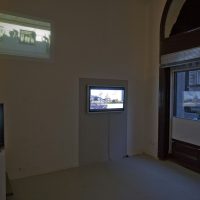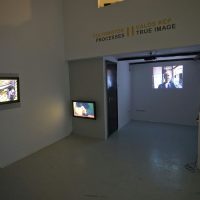Immediately visible or less noticeable at first, the movement, the change in the imagesis perpetual, and builds up to a rhythm. It turns into a picture on the wall, yet, it does not tell a story. Instead, it shows the states of movement, the processes of change.
In Processes II, the works are based on real video recordings. The viewer sees real images. Some of them are taken out of their orginal context (Szacsva y Pál, Révész), while others are seen through the camera (Kisseleva), juxtaposed (Stracke), or are constructed artificially (Aggtelek, Koronczi). And these images come to live their own lives. They become works of art.
The works of art belonging to the above-mentioned category have a feature which is worth examining more thoroughly: namely, their conceptual and formal differences determine the way of their presentation. It is not the same whether we see videos in a cinema, as part of an installation, or as moving pictures.
This classification corresponds to a certain extent to the possible conceptual-formal structures: a video can be narrative, it its beginning and end are significant; A series of figurative or abstract images, closely bound to their enviroment; or the observation of phenomena within the medium, within the electronic space.
Eike: Softmanipulations

